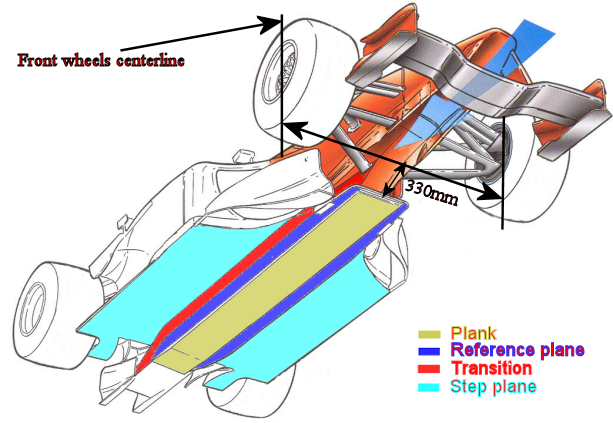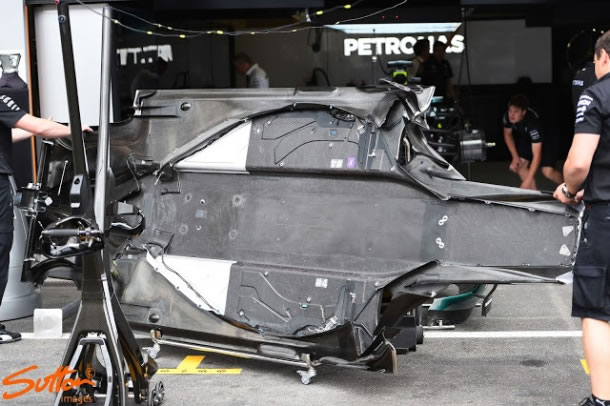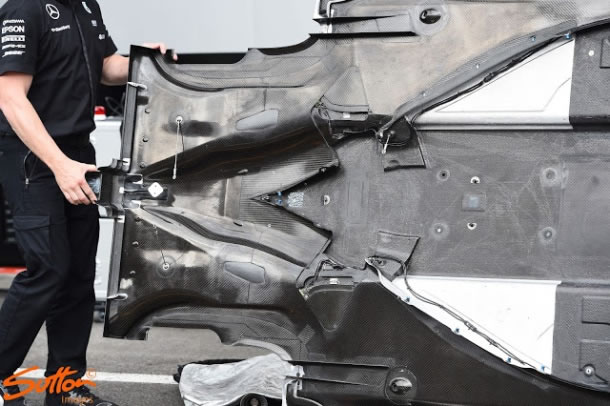Undertray or underbody
Underbody tunnels, rear diffusers and venturis are common terms used to describe the contouring of a racing car's underbody. While largely hidden from view, these devices are the secret weapons in an arsenal of aerodynamic features for generating downforce on racing cars. The origins of the rear diffuser can be traced back to the 1977 Lotus Type 78 F1 car conceived by Colin Chapman, Peter Wright and Tony Rudd. In a brilliant example of lateral thinking the Lotus team applied the well known "airplane in ground effect" principle (reduced drag) to a racing car and found a significant increase in downforce with minimal increase in drag as a result. By incorporating inverted (compared to an aircraft) airfoil sections into the sidepods of their car, the era of ground effects in Formula 1 was started. A side skirt was connected to the edge of the sidepods and extended down to the road surface. This skirt helped maintain 2D flow characteristics that provide increased downforce and reduced drag compared to a typical 3D wing. The side skirts also hid the new device from the prying eyes of competitors. Even so-called "flat bottomed" racing cars, such as those in F1, can create significant downforce from a well-shaped small diffuser. Cars without scope for a diffuser can still generate downforce from a slanted lower surface at the rear of the car in combination with a rear wing.
Undertray or underbody (picture above Nico Rosberg's 2012 Mercedes AMG F1 W03, click on it for bigger picture) is aerodynamically the strongest contributor to the lap time. Very low drag to downforce ratio is important to take into consideration during design. Underbody is working in very close relationship with front wing and splitter in the front of the car (feeding the air to underbody) and diffuser on the back (extracting the air from under the car). A Formula 1 car produces much of its downforce from its underside, and you can think of each component of it as a link in a long chain. Change one without altering the rest and everything is then out of alignment—the car's aerodynamics simply won't work as intended.
F1 rules prohibit under-car shaping or venturis, and mandate a minimum ride height enforced by a relatively low-tech wear plank attached underneath the car. Underbody must be, by the rules, completely flat, except for plank and Reference plane. However, there is still scope to shape the diffuser area directly under and behind the rear axle line.
As part of the package of aero changes designed to reduce downforce for 2009 and then again 2011, the diffuser has undergone quite complex modifications. Moves to create a more standardised shape have removed the difference in height between the central and two outer sections and all three channels are now taller - 175mm rather than 125mm. In addition, the diffuser has been moved rearwards, with its trailing edge now 350 mm behind the rear axle - previously, it was level with the rear axle.
Only diffuser by itself can produce significant downforce, approximately 35% of the total car downforce.
Teams still use different trickery to increase efficiency of underbody and diffuser. For example, the forward barge board you can see on the picture of Mercedes F1 car up, acts solely as a vortex generator. They're cambered like a wing. The rotational direction of that vortex will be counterclockwise, and because the vortex is traveling downward, it sends down-wash approaching the underbody, feeding it with additional air and acting as the curtain, which is very favorable. It essentially generates more downforce. The car's keel split the column of incoming air underneath the monocoque sideways and out of the way. It's shaped very carefully and designed with the barge boards in mind to generate higher airspeed and thus low pressure.
The sculpted sidepod turning vanes play a vital role in routing the dirty, turbulent wake of air coming off the front tires. They delay how long it takes before that front-wheel dirty wake starts entering under the floor and taking downforce away.
The leading edge of the floor will generat vortices that will then spin down underneath the floor, along the edge of the reference plane, and all of that vortical action reduces the total pressure under the floor and gives you more downforce.
The complication on the perfect diffuser and floor performance comes form the shape of the underbody of the Formula 1 car. The area under the car is regulated to form basically two flat bottoms. All we normally see of the underbody is the splitter, sides and exit of the diffuser and sometimes, if seen from a low angle, the step under the cars floor. The stepped underbody was introduced to reduce the effectiveness of the diffuser, and the plank was introduced to prevent the teams running the very low ground clearances to enhance the effect of the diffuser.
You can also find all relative data of underbody precisely described in FIA rules, but they are so complicated and hard to understand to anybody except F1 engineers, but you can try!!!
I will try to describe parts of the Formula 1 underbody, beginning from one closest to the ground - up.
But first, a small explanation: In the FIA Technical Regulations the underbody or undertray surfaces are called “Bodywork facing the ground”, and there is no term ‘diffuser’ or ‘wing’ mentioned in the rules. Just as with any bodywork in the rules, these parts are not allowed to move or flex more that specified in regulations. For the floor in comparison to the wings, there are few deflection tests commonly carried out during crash test, the main one being the splitter deflection test and fuel tank penetration test carried from below the floor.
And here we go!!


Plank
There is an article in my F1 dictionary dedicated to plank or skid block as is called in f1 circles, so you can check there, but I will describe it here again in shorter version.
Beneath the reference plane lies the skid block or 'plank' and running all the way along the reference plane. It must run from the frontmost point of the reference plane at 330mm behind the front wheels centerline to the rear wheels centerline. It is not considered part of the floor for measurement purposes, and is there only to enforce a minimum ride height.
It must be made out of a material with a specific gravity of between 1.3 and 1.45, to prevent excessively heavy or hard planks producing a performance benefits and lowering the car center of gravity. Typically the plank is wood based, either jabroc, a laminate of beechwood, although more exotic blends of woods and resins not unlike MDF have been used.
Must measure 300mm in width, with a tolerance of 2mm. Although it decreases in thickness towards the edges to allow a smooth design, the plank most importantly, when measured through six pre-cut 5cm diameter holes, has a tolerance of just one 1mm on its 10mm thickness. Holes in the plank allow measurement of the thickness and the cars reference plane to sit directly and exactly on right place on the FIA scrutineering platform, for legality checks over the course of a GP weekend.
Little more up is Reference plane
After ground effect was banned and flat bottom rule introduced 1983, speed of the car and downforce produced by flat floor went up every year more and more. Flat bottom rule was revised again after Senna death 1994, and from that year the floor has to have a step along its length. That’s why we see the stepped shape of the car in frontal profile, with the reference plane sitting lowest in the middle of the car. The reference plane, which is the part all heights of the car are related to (datum for all other measurements), is defined as the lowest part of the floor of the car (excluding the plank) and runs along the centre of the car and must meet a minimum width and length. The reference plane starts on splitter (T-Tray or Bib) 330mm behind the front wheel centre line and go all the way to the rear wheel centre line, and must be between 300mm and 500mm wide and symmetrical about car centre line. Reference plane must have a 50mm radius (+/-2mm) on each front corner when viewed from directly beneath the car. At it sides it leads through a radiused edges and transition plane (or step) to the step plane.
Step or Transition
In between the reference plane and step plane, is the step or transition. By the rules there must be a vertical surface in between reference plane and step plane 50mm high. Any intersections of these surfaces are allowed to have a radius no greater than 25mm on the step plane and no greater than 50mm on the reference plane. All parts lying on the reference and step planes, in addition to the transition between the two planes, must produce uniform, continuous and rigid surface with absolutely no degree of freedom or movement in relation to the body of the car.
And here we are, on the Step plane
The larger, higher area of floor is the step plane. The step plane must be 50mm above the reference plane. It starts 330mm behind the front wheel centre line and extends to the rear wheel centre line. It is an extremely important area of the car because even though its curvature is banned, the flat bottom creates over a third of the car's downforce because the car's aerodynamics work best the closer they are to the ground - so it's an area that the FIA are very keen to restrict. Step plane is the level at which any bodywork viewed from the underside of the car, and which is not on the reference plane must stop. What that’s mean? If you are below the car and looking up, all bodywork (bargeboards, sidepods, winglets, grilles) must be hidden and can’t be seen. No unsprung part of the car can be visible from below the floor. This means anything, but the suspension, wings and rear view mirrors are excluded from this limitation. This also means that no holes can be made into the floor to let air flow in or out.
To help overcome any possible manufacturing problems, and not to permit any design which may be against regulations, dimensional tolerances are permitted on step plane. A vertical tolerance of +/- 5mm is permissible across the surfaces lying on the reference and step planes and a horizontal tolerance of 5mm is permitted when assessing whether a surface is visible from beneath the car. Again, same as all parts of underbody, surface must be flat and produce uniform, continuous and rigid surface with absolutely no degree of freedom or any movement in relation to the body of the car. A large clearance is mandated around the rear wheel to prevent teams sealing off the floor against the rear tires.
Diffuser
To know more about diffuser or exhaust blown diffuser check my articles with more in detail explanation.
A purely flat floor would probably produce lift rather downforce, so the rules have allowed a diffuser to be fitted to the rear of the underbody since 1983. Before that date there were no rules demanding floor dimensions and diffusers were the full length ground effect tunnels that typified the wing cars of the late seventies and early eighties.
A diffuser creates downforce by creating a pressure differential, and serves to eject air out from the underside of the car. This pulling action decreases the velocity of the air below the car, so that the more slowly moving air above the car will push the car into the ground with low pressure beneath and higher pressure above. The larger a diffuser is the more expansion ratio is has, thus more potential to create downforce. Diffusers were limited to a simple 1000m width, 350mm length and 175mm height from 2009. Then for 2011 the height is further reduced to just 125mm. This massively reduces the potential of the diffuser to create downforce compared to the previous rules. Diffusers are allowed to have fences, but the fences and the diffuser itself must not form undercuts when viewed from below.
Exploitation
Over the past two year these rules have been exploited by teams.
The teams converge the sides of the step plane towards the rear of the car into a point. The edges of the step join into a Vee just before the rear axle line. This converging speeds up the air flow along the vertical edge of the step. The flow along the vertical edge of the step is very poor, the teams use the shape of the end of the step plane to improve the flow and pull the air through the diffuser. The resulting Vee in the start of the centre channel is useful to accommodate the end of the gearbox.
Another development some of the teams use is another ramp low down in the centre channel, this additional ramp starts at the axle line and as low down as possible, the aim of this is to pull air from the space between the track and the plank.
During double diffuser period2009 and 2010, teams exploited the rule in “floor continous surface” wordings. Teams opened the holes in vertical transition surface. Rules stipulate that no bodywork can be seen when looked from below the car and any part of the floor must be “continous surface”. Because holes are in vertical plane, no bodywork can be seen. And with holes, surface was still continuous. This lead to the openings that allowed double diffuser. Effectively the step formed two separate, but individually continuous surfaces, allowing airflow to pass up above the step plane into the upper deck of the diffuser. This rule has been clarified for 2011 and now a “single continuous surface” must be formed under the floor.
Additionally the flexibility of the splitter has been brought into question, teams were believed to be flexing the splitter upwards, and new more stringent tests were introduced in 2010 to stop this.
Few pictures of upper side of Mercedes AMG F1 undertray:


Back to the top of the page







